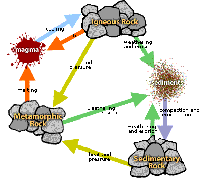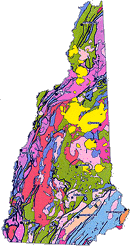Shake
...
Hold on to your
seats, because an awful lot happened in the Devonian Period
[deh-VOH-nee-in] in New Hampshire. For instance, the Littleton Formation
(named for Littleton, NH where the rock was first identified) was
developed in much the same way as the Fitchburg Formation was during
the Silurian Period. The slow but steady collision of the North
American and African tectonic plates - and the frictional heat
that goes with it - squeezed the muds , marine skeletons and chalky
carbonates first into sedimentary rocks
and then into very hard, erosion resistant metamorphic rocks.
Later, this collision will result in some igneous rock
formation.
When tectonic
plates collide,
causing the Earth's surface to compact and crumple, earthquakes happen.
Earthquakes
can also happen when tectonic plates separate from
each other, during
volcanic eruptions, from uplifting and settling. Since all of
these
things have happened at one time or another in New Hampshire's history,
we
know there have been earthquakes here. In fact they are still
occuring.
See the box at right for more.
... and Bake
The above mentioned
sediments were transformed into schist [shist], quartzite
[kort-zite] and carbonate
[kar-bo-nate] rocks. These rocks are now among the hardest and
most erosion resistant in the state.
Getting caught
between colliding tectonic plates and being baked by intense heat miles
under the surface would make these metamorphic rocks. The heat
came from the friction of the slowly building, but ever increasing,
pressure and/or from the interior of the Earth.
See the Rock Cycle at
right for more information
about the different kinds of rock out there.
The Missing Link
If parts of New
Hampshire's bedrock was formed from rocks created from sea floor
sediments, where are the sedimentary rocks? Where are the fossils
of sea creatures that should be embedded in those sediments?
The first question
has already been partially answered. Those sediments were, for the
most part, crushed between tectonic plates and baked under the heat of that collision, the heat from Earth's interior, or both.
The
other part of the answer is that there has been little or no geologic
building up of the Eastern portion of North America, where we live, for
about 180,000,000 years or so. That means there has only been the
wearing down forces of weathering and erosion at work.
Sedimentary rocks are pretty soft and easily broken down by wind,
water and glacial weathering and erosion - just look at the Grand
Canyon
for an example.
There you are then: The sedimentary rocks that formed in New
Hampshire were either broken down and carried away, or they were
squeezed and baked into metamorphic rocks. There is a third
option, discussed below in the section about the Concord Granite.
As for where the
fossils are, they were either weathered and eroded away with the
sediments they formed in, or they were caught in the metamorphosis
process and were destroyed beyond recognition.
There are, however,
a few greatly distorted fossils to be found in New Hampshire, most
notably on the eastern side of Mt. Moosilauke and in a few isolated
spots in the Littleton area.
The Name Game
You probably
already
know that New Hampshire has the nickname of 'The Granite State'.
But
do you know why it is called that?
Is it because most
of the rock in New Hampshire is granite? Nope. Most rock in
New Hamshire is rock other than granite.
Is it because the
pioneers built their houses with granite? Nope again. While
many house foundations were made from the stones found on that house's
property,
it depended on what part of the state you were in if those rocks were
granite or not. You will find some houses made of granite, but
these were built well after the pioneers settled here. Most
people found it too costly in time, effort and money to build houses
from granite. Trees were much easier, and cheaper, to work with.
New Hampshire
became
the Granite State mainly due to the 19th Century building boom in
Boston,
New York City and Washington, D.C. Other smaller cities and towns
also
used granite in municipal buildings and for monuments as well.
Two
of the types of granite were quarried extensively and shipped
widely,
spreading the fame of New Hampshire's granite. One is a
pinkish-orangish
stone known as the Conway Granite and the other is a grayish stone
known
as the Concord Granite. Both granites got their names from the
towns
they were first quarried from.
The Concord Granite
Of the two major
kinds of granite exported in the building boom of the 19th Century,
only the
Concord Granite was formed in the Devonian Period.
Geologists
beleive that the rock that is now the Concord Granite was a bed of
sediments
that was melted from the intense frictional heat of the continental
collision. Today, Concord Granite is still quarried for curb
stone, window sills, kitchen countertops and many other uses.
Hail To The Chief(s)
If you were to name
a famous mountain in the state, chances are you'd come up with Mount
Washington. It just so happens that Mount Washington and the
Presidential Range are not made of granite. These mountains are
made from the very
erosion resistant schists of the Littleton Formation. Another
famous
mountain in the state belongs to the Littleton formation way down in
the southwest corner of the state - Mount Monadnock!
The rocks of both
Mount Washington and Mount Monadnock are so hard, that the rock around
them has eroded away, leaving them standing so tall.
Buried Treasure
The Devonian
Period's igneous rock formations also created some of the most
beautiful and valuable minerals, some of which are only found in this
state. Ruggles Mine is one place where the public can visit to
mine their own mineral specimens.
|
|
| Earthquakes? In New
Hampshire? |
|
Yup, we do earthquakes here. Since colonial times, there have
been ocassional reports of quite sizeable quakes that could have been 6
or 7 on the Richter Scale that
caused widespread damage. It is believed the epicenters for these
larger quakes were outside of New Hampshire. Having said that, there
have been a few centered in the Tamworth, Moultonborough and Ossipee
area that have toppled chimneys and moved houses off their foundations!
Fortunately most quakes centered here are usually very weak.
|
| The Rock
Cycle |
|

No, it's not
some kind of extreme off-road bicycle. The Rock Cycle refers to the
constant process whereby rocks are formed in one of three ways, and how
they can change into any of the other types during the course of their
existence.
(Click on the image for a closer look.)|
Image credit: Earth
Science Explorer
|
| The
Granite
State |
|
In granite, the
three minerals crystallize as the magma cools.The longer the magma has
to cool, the bigger the crystal sizes are because they have more time
to organize themselves. Look at the two pictures below.
Which type of granite had more time to cool?
 Conway Granite Conway Granite
 Concord Granite Concord Granite
(Click on the image for a closer look.)|
Image
credit: Daniel E. Reidy
|
| The Most
Climbed Mountain In The World |
|
 New Hampshire is
home to the most climbed mountain in the world - Mount Monadnock.
This honor used to fall on Mount Fuji in Japan, but a tram was
recently installed on that mountain. That means not all who reach the
top now, climb there. New Hampshire is
home to the most climbed mountain in the world - Mount Monadnock.
This honor used to fall on Mount Fuji in Japan, but a tram was
recently installed on that mountain. That means not all who reach the
top now, climb there.
'Monadnock' is an Abenaki term that loosely translated means 'mountain
that stands alone'. As a result, geologists around the world use the
term 'monadnock' to mean any hill or mountain that rises up from low
lying surrounding countryside.
The Littleton Formation appears light blue on the NH Bedrock Geologic
Map.
Can you locate where Mount Washington and Mount Monadnock are?
(Place your mouse cursor over the map for the locations.)
(Click on the image for a closer look at the map.)|
|
|